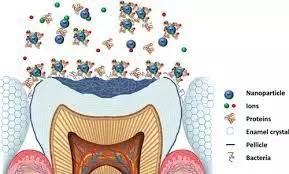Amalgamation of Chitosan capped nanoparticles into dentine bonding agents may prevent secondary caries

CuO nanoparticles and CuO-Chitosan nanoparticles can be effectively used for drug delivery, according to a recent study.Further amalgamation of Chitosan capped nanoparticles into dentine bonding agents may prevent secondary caries.
The study has been published in the international journal of biological macromolecules.
Nanotechnology deals with the physical, chemical, and biological properties of structures and their components at nanoscale dimensions. Nanotechnology is based on the concept of creating functional structures by controlling atoms and molecules on a one-by-one basis. The use of this technology will allow many developments in the health sciences as well as in materials science, bio-technology, electronic and computer technology, aviation, and space exploration. With developments in materials science and biotechnology, nanotechnology is especially anticipated to provide advances in dentistry and innovations in oral health-related diagnostic and therapeutic methods.
This investigation is vital contribution to the healthcare system utilizing techniques of nanobiotechnology. It interestingly applies chitosan capped CuO nanoparticles in the field of medicine and restorative dentistry. The CuO nanoparticles and CuO-Chitosan nanoparticles are prepared by co-precipitation, and their characterization is performed using X-ray diffraction (XRD), Fourier transform infrared spectroscopy (FTIR), scanning electron microscopy (SEM), transmission electron microscopy (TEM), and energy dispersive X-ray (EDX). The average crystallite size of these nanoparticles has been found to be in the dimensions of <40 nm and <35 nm, respectively. CuO-Chitosan nanoparticles show significant enhancement in in vitro antibacterial, antioxidant, cytotoxic, and antidiabetic activity as compared to CuO nanoparticles. In addition, the successful amalgamation of CuO nanoparticles and CuO-Chitosan nanoparticles into dentine bonding agents results in providing efficient remedy against secondary caries. CuO-Chitosan nanoparticles reinforced dental adhesive discs cause significant upsurge in reduction of Lactobacillus acidophillus and Streptococcus mutans. Also, the augmentation of mechanical properties, water sorption and solubility plus slow and sustained release profile and slight variation of shear bond strength is attained.
Thus, the researchers concluded that taken together, the chemically synthesized CuO nanoparticles and CuO-Chitosan nanoparticles have proven to be promising candidates having enormous potential to be utilized in drug delivery and nanotheranostics.
Reference:
Chitosan capping of CuO nanoparticles: Facile chemical preparation, biological analysis, and applications in dentistry by Rabia Javed et al. published in the international journal of biological macromolecules
https://doi.org/10.1016/j.ijbiomac.2020.11.099